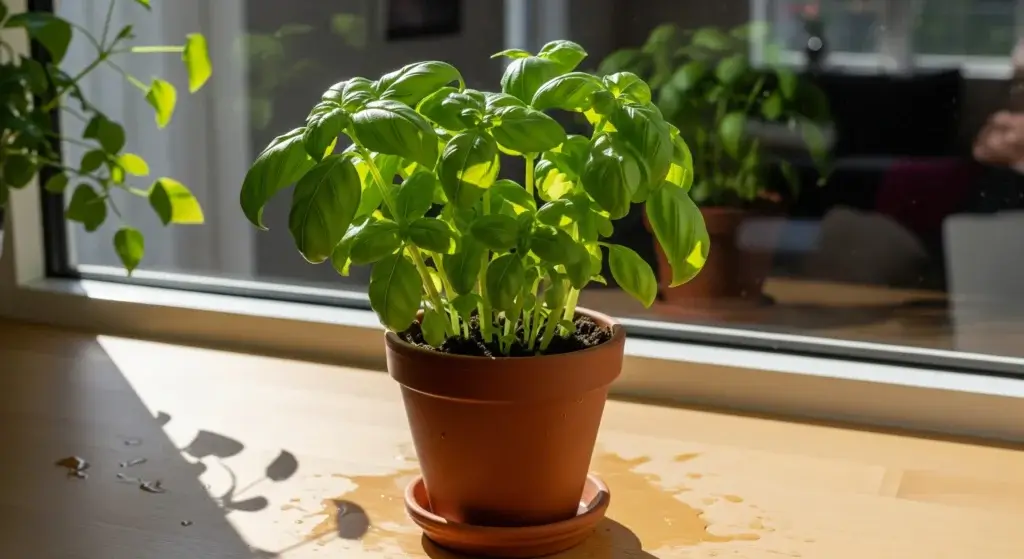
Growing cucumbers in containers is a total game-changer—perfect for balcony gardeners, patio peeps, or anyone short on space (looking at you, city folks). You don’t need a backyard; just a pot, some sunshine, and a plan.
In fact, potted cukes can actually outperform garden ones if you do it right.
It’s like giving your plants VIP treatment—better soil, less drama, and front-row seats to the sun.
Plus, they climb, so it’s like having a cucumber jungle gym on your porch.
Why Choose Container Cucumber Growing?
Think of container cucumber growing like putting your cukes in VIP seating—they get better treatment, and you get better results.
Instead of planting in the wild wild west of garden soil, you’re giving your cucumbers a penthouse suite where you control the soil, water, and even who gets to hang out nearby.
Space efficiency and mobility
No yard? No problem.
With containers, you grow up, not out. Like Spider-Man scaling a building, cucumber vines love to climb.
One container can crank out 10–15 pounds of cucumbers if you treat it right.
Bonus: If the weather throws a tantrum (looking at you, surprise heatwaves), you can just move the pot.
Try doing that with a garden bed.
Enhanced pest and disease management
Growing in containers is like putting cucumbers in a gated community—harder for pests and diseases to crash the party.
You’re not dealing with weird stuff hiding in the soil, and it’s easier to keep tabs on what’s going on.
If something does go wrong, you can spot it faster than Netflix cancels your favorite show.

Sunlight and Positioning Requirements
Your cucumbers? They’re sun addicts. They want at least 6 to 8 hours of full sun a day.
No shade. No slacking.
They’re out here living that tan-line life.
Move it or lose it
The best part about growing cucumbers in containers? You can chase the sun like a plant version of a solar panel on wheels.
If one corner of your balcony turns into a shady lounge, move the pot.
Cucumbers don’t do “low light vibes.”
Morning sun = Health kick
Get your cucumbers some good morning sun—it dries off the dew before fungi can crash the party.
Think of it like a morning shower to keep the leaves clean and disease-free.
Afternoon sun = Growth mode
That afternoon sun? That’s where the magic happens.
It’s the cuc’s version of an energy drink—boosting photosynthesis and helping the plant bulk up and pump out those fruits.
Hot weather pro tips
When it’s blazing outside (90°F+), even cucumbers need a break.
Give them a little afternoon shade or move them somewhere cooler.
It’s like handing them sunglasses and a cold drink—less stress, more cucumbers.
Watering and Moisture Management
Cucumbers in containers are a bit high-maintenance when it comes to water.
They’re like that friend who drinks three bottles of water but still complains they’re thirsty.
You’ve gotta keep an eye on them—daily.
Watering frequency and technique
Check daily—no joke. Stick your finger 1–2 inches into the soil. If it feels dry, it’s watering time.
Think “moist brownie,” not “mud pie” and definitely not “desert floor.”
When you water, go slow. Let it soak deep so the whole root zone gets a drink.
You want to see water coming out the drainage holes—like a satisfying mic drop.
Signs of proper watering
- Soil feels damp a couple inches down
- No puddles sitting in the tray like sad soup
- Plants look upright and proud, not floppy like they just watched a season finale
- No wilting when the sun’s blasting
Moisture retention strategies
- Mulch the top of your container with straw, shredded leaves, or coconut coir. It’s like giving your soil a sunhat.
- Use self-watering pots or drip systems if you want low-effort, high-reward watering. It’s basically plant-level auto-pilot.

Support Systems and Vertical Growing
Even the bushy cucumbers appreciate a little vertical action.
Support systems aren’t just about looking fancy—they keep your plants clean, healthy, and way easier to harvest.
Plus, cucumbers hanging on a trellis = instant garden street cred.
Trellis options for containers
- Tomato cages – Perfect for bushy types. Easy. No tools. Very “starter pack” vibes.
- Bamboo teepees – Rustic, functional, and makes you look like you totally know what you’re doing.
- Wire panels – Great for wild vining cucumbers that need to be tamed like a jungle cat.
- String systems – Pro gardener mode. Think of it like plant parkour training—clean lines, big yields.
Training and pruning techniques
- Gently tie the vines with soft ties or clips. Think loose ponytail, not tight bun.
- Remove leaves near the soil. They’re just begging to pick up disease like it’s on sale.
- Got random side shoots (aka suckers)? Pinch them off. Less drama, more cucumbers.
Fertilization and Nutrient Management
Cucumbers in containers are hungry all the time.
They’ve got limited soil and get watered a lot, which means nutrients wash out faster than spoilers on Twitter.
If you don’t feed them right, they’ll sulk—and no one wants sad cucumbers.
Feeding schedule and requirements
Start feeding them 2–3 weeks after planting.
Use a balanced veggie fertilizer like 10-10-10 (aka the cucumber version of a balanced breakfast).
Here’s what they crave:
- Nitrogen – Builds big leafy vines. Think of it as gym fuel.
- Phosphorus – Makes flowers and fruits happen. No phosphorus = no cucumbers = sad sandwich.
- Potassium – Helps the fruit taste better and fight off plant cooties.
Feed every 2–3 weeks like clockwork. As the weather cools down near the end of summer, you can ease up a bit.
Organic fertilization options
- Compost tea – It’s like a smoothie for your soil.
- Fish emulsion – Smells gross, works great. Plants love it.
- Worm castings – Basically worm poop. But like… superfood worm poop.
Keep it consistent, and your cucumbers will grow faster than a trending TikTok dance.
Common Pests and Disease Management
Your cucumbers might be living their best life in a container, but pests and diseases are always trying to crash the party.
The good news? Growing in pots makes it easier to spy the troublemakers and kick them out before things get ugly.
Primary pest concerns
- Cucumber beetles – These tiny striped or spotted jerks chew leaves and spread bacterial wilt like it’s hot gossip. Squash them on sight.
- Squash bugs – Big, brown, and extra. They stab the plant and inject toxins. Pick them off by hand like you’re playing whack-a-mole. Smash their eggs too.
- Aphids & whiteflies – Tiny clingy bugs that hang out under leaves and suck the life out of your plants. They also spread viruses like it’s their full-time job.
Disease prevention strategies
Cucumber diseases love moisture and bad airflow. You’re growing in containers—use that to your advantage:
- Space your containers so air can move around. Think: no plant traffic jams.
- Water the soil, not the leaves. Cucumbers like baths, not showers.
- Toss dead leaves. Don’t let fungus set up camp.
Organic Treatment Options
- Baking soda spray – Makes the leaf surface less cozy for fungus. It’s like antifungal armor.
- Neem oil – Works on bugs and diseases. Smells weird, works wonders.
Pro tip: spray early in the morning or late in the day so the sun doesn’t fry the leaves.

Seasonal Care and Maintenance
Cucumbers aren’t just “plant and chill.” They’ve got a seasonal rhythm—and if you want max crunch, you gotta vibe with it.
Mid-season
Your cucumber plant is now in full production mode—leaves everywhere, fruit popping out like it’s on caffeine.
- Keep feeding weekly and check for bugs like it’s your part-time job.
- Once temps hit 90°F or higher, your plant might start slacking on fruit. Give it some afternoon shade—a little plant siesta keeps production rolling.
End-of-season
As summer fades, your cucumbers start slowing down.
- Water less and stop fertilizing so the plant can wrap things up naturally.
- First frost = game over. Harvest what’s left before your cucumber turns into a popsicle.
Season extension techniques
Want more cucumbers into fall?
- Row covers or cold frames can stretch your harvest a few extra weeks.
- Or just move the container to a warmer, more protected spot—container growing for the win.
So ride the cucumber season like a good Netflix series: start strong, adjust with the plot twists, and wrap it up before the frost drops the finale.
Troubleshooting Common Problems
Sometimes your cucumber plant throws a tantrum.
Don’t panic.
Most issues are easy to fix once you know what’s going on. Here’s how to deal like a pro.
Poor fruit set
This usually means poor pollination. Bees might be skipping your balcony.
Fix it: Grab a tiny paintbrush and play matchmaker.
Dab pollen from a male flower (skinny stem) to a female flower (tiny cucumber behind it). Boom—plant baby made.
Bitter cucumbers
Bitterness = plant stress. Usually from wild watering habits, heat waves, or lack of nutrients.
Fix it: Water consistently, keep the plant cool during hot spells, and don’t forget to feed it.
Also, harvest early—the longer cukes sit, the grumpier they get.
Stunted growth
If your plant’s stuck in slow-mo, blame one of these:
- Container’s too small
- Crusty, tired soil
- Forgot the fertilizer
Fix it: Make sure each plant gets a pot that’s at least 5 gallons, use good potting mix, and feed regularly. Basically, give it space, food, and a reason to grow.
Maximizing Your Container Cucumber Success
Growing cucumbers in containers takes more effort than in the ground—but it’s 100% worth it.
You control the soil, the sun, and the drama.
Start with the right variety, give it a roomy pot, water like clockwork, and keep bugs in check.
Boom—crispy, homegrown cucumbers all season.
Yeah, it takes some TLC, but it’s super space-efficient, beginner-friendly, and kind of addictive (in a good way).
Start small, level up each season, and before you know it, you’re that friend handing out cucumbers like it’s your side hustle.



